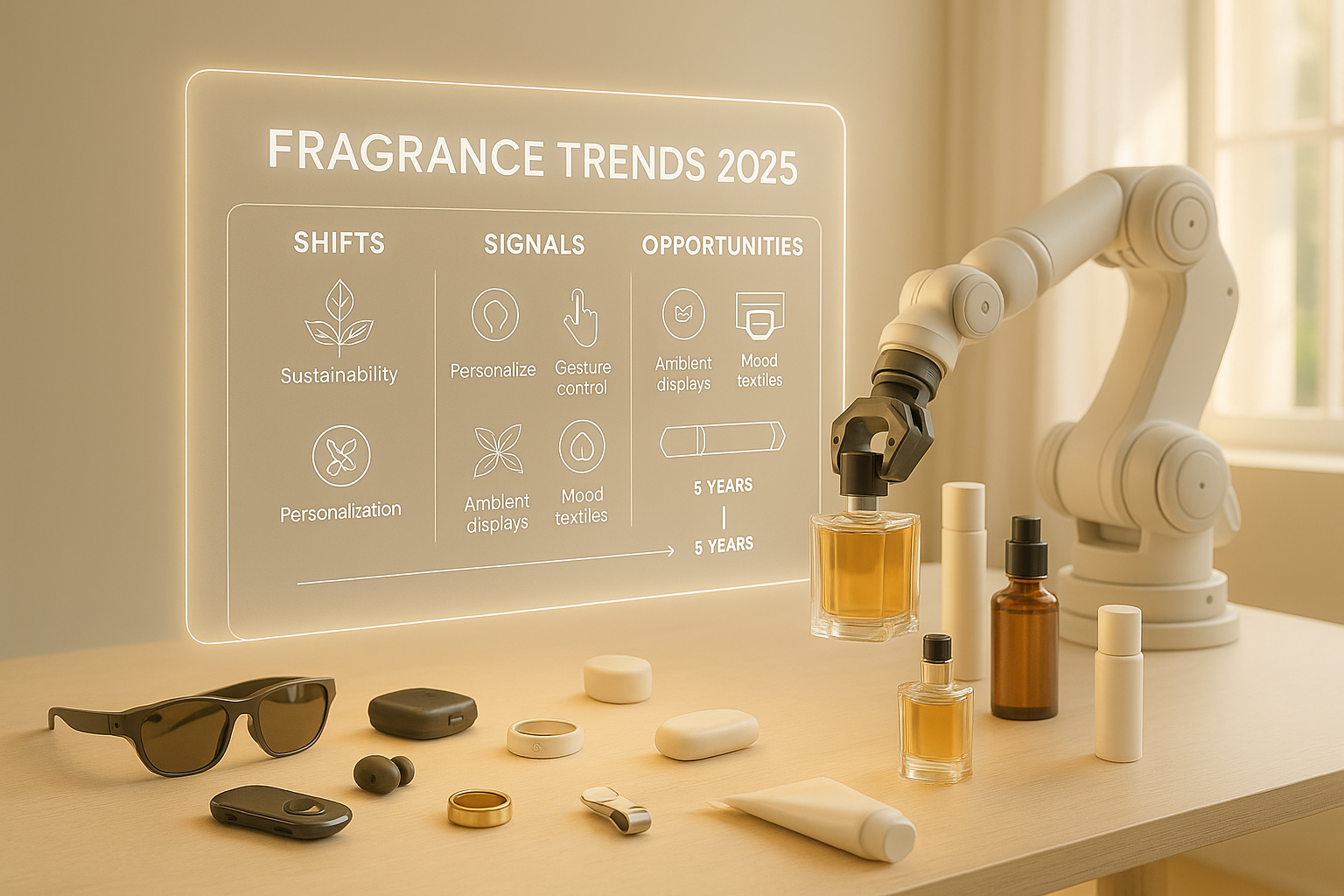H2 Fragrance Trends 2025: Insights and Outlook
The fragrance business is changing quickly. Since the start of the year, shifts in performance, consumer behavior, and innovation have already begun shaping the rest of 2025 and laying the foundation for 2026. Prestige fragrance continues to outperform, regional markets are becoming growth engines, and fragrance innovation is moving from the lab into everyday use.
US and Global Fragrance Market Insights 2025
In the United States, fragrance remains the strongest category in beauty. According to Circana1, prestige sales rose by 4% in Q1 2025, while mass fragrance climbed by 8%. Minis and travel sizes surged by more than 45%, reflecting the consumer appetite for discovery and portability. Higher concentrations such as parfums and eau de parfums also gained traction, with average prices rising 6% year on year as buyers seek intensity and long-lasting performance.
On a global scale, the fragrance market is forecast to expand at about 8% CAGR through 2030, one of the most resilient categories in beauty. Niche fragrance is projected to nearly double, reaching $13.5 billion by 2030.
Two regions stand out as growth engines. The Middle East fragrance market was valued at $3.76 billion in 2024 and is projected to grow at 7.5% CAGR through 2034. Consumers in the region spend 25–30% more per purchase than the global average, with ultra-premium oils, capsules, and personalized blends leading the way. Discovery often happens in luxury hotels, spas, and airports rather than beauty retail.
Meanwhile, Latin America is now the world’s second-largest fragrance market, valued at $6.9 billion in 2024 and expected to surpass $11.4 billion by 2034. Growth is supported by both domestic demand and a surge in cross-border e-commerce, expanding at more than 30% annually. Regional influences—from Amazonian florals to cactus-inspired accords—continue to shape both mass and prestige perfume industry trends.
Consumer Behavior and Perfume Industry Trends 2025
Consumer preferences are reshaping how the fragrance business grows. Only 13% of buyers now say a founder’s story is their reason for purchase; instead, product quality, value, and shared values dominate.
Layering has gone mainstream, with consumers building scent wardrobes across perfumes, body mists, lotions, and hair products. Minis, rollers, and solids have become popular entry points, lowering the barrier to trial while driving loyalty. Sustainability is no longer an add-on—it is an expectation. Ingredient transparency, refillable packaging, and biosynthetic formulas are increasingly tied to perceptions of both trust and luxury.
At our recent Fragrance Futures Salon, which convenes fragrance industry and science innovation professionals rather than consumers, a designer working on personalization technologies described how they are collaborating with scientists and chemists to accelerate stability testing for fragrances created on the spot. We also discussed how the industry often treats functional fragrance as established, while for consumers it remains relatively new. Few realize that scents can be intentionally designed to influence mood and behavior based on neuroscience. Another theme was the sourcing of non-traditional ingredients—materials that sit outside a perfumer’s usual palette and don’t necessarily smell “perfumey” but provide unique olfactory experiences.
Fragrance Innovation, Signals, and Future Research
Technology and academic research are rapidly expanding the definition of fragrance innovation.
On the signals side, artificial intelligence now enables a fragrance to move from concept to first sniff in less than 48 hours, compressing development timelines by more than 70%. Research into multi-sensory experiences shows that pairing scent with voice enhances emotional impact and memory retention, opening new possibilities for immersive retail and branded environments. Personalization platforms are gaining traction across regions, giving consumers the ability to design custom scents that reflect cultural preferences. Advances in textiles are also making scent part of daily rituals, with microcapsule technologies embedding fragrance directly into fabrics and wearables.
Meanwhile, academic research is pointing to what comes next. Millisecond emitters are capable of delivering scent almost instantly with minimal energy use, enabling compact, responsive devices. Gesture-activated scent prototypes allow mid-air hand movements to trigger olfactory cues in virtual environments. Ambient scent displays are being tested as ways to create fragrance zones across entire rooms, while mood-linked textiles connect scent release to biometric data in real time. These innovations suggest a future where fragrance is not just worn but embedded into environments and interactions.
The Future of the Fragrance Business
The months ahead will be defined by opportunities where culture and technology intersect. Regional gifting traditions and holiday moments remain strong discovery drivers. Layering can be reinforced with routines and wardrobe-like sets. Biosynthetic and traceable ingredients can become central to product storytelling, positioning sustainability as luxury. And connected technologies can make fragrance discovery faster, more intuitive, and more sensory.
The second half of 2025 should be seen as the beginning of a new cycle. Regional growth, shifting consumer expectations, and accelerated fragrance innovation are already reshaping the global fragrance market. For leaders, the question is not whether the industry will change, but how to capture the opportunity. At Future of Smell, we help companies and founders translate fragrance trends 2025 into clear strategies—deciding where to play, how to differentiate, and how to lead in a perfume industry that is becoming more connected, more personalized, and more central to consumer life.
Reference Links -
1. Circana — US Beauty Q1 2025 Report (Prestige +4%, Mass +8%, Minis +45%)
https://www.circana.com/post/mass-beauty-us-sales-growth-outperforms-in-q1-as-prestige-remains-flat-circana-reports
BoF x McKinsey — The State of Fashion: Beauty 2025 (Fragrance growth outlook)
https://www.mckinsey.com/industries/consumer-packaged-goods/our-insights/state-of-fashion-beauty
Verified Market Research — Global Niche Fragrance Market 2025–2030 Forecast
https://www.verifiedmarketresearch.com/product/niche-fragrance-market
Expert Market Research — Middle East Fragrance Market Report 2024–2034
https://www.expertmarketresearch.com/reports/middle-east-fragrances-market
Expert Market Research — Latin America Perfume Market Report 2024–2034
https://www.expertmarketresearch.com/reports/latin-america-perfume-market
Euromonitor — Sustainability and Refills in Beauty 2025
https://www.euromonitor.com/article/sustainability-claims-unpacked-rethinking-refill
Nature Communications 2024 — Millisecond Odor Emitters Research
https://www.nature.com/articles/s41467-024-48884-z
ACM CHI 2025 — Gesture-Activated Scent in VR
https://dl.acm.org/doi/10.1145/3706598.3713964
Building and Environment 2025 — Ambient Scent Displays in Mixed Reality Spaces
https://www.sciencedirect.com/science/article/pii/S0360132325000903
ACS Applied Materials & Interfaces 2024 — Advances in Microcapsule Design for Textiles
https://eprints.whiterose.ac.uk/id/eprint/222245/1/lobel-et-al-2024-current-challenges-in-microcapsule-designs-and-microencapsulation-processes-a-review.pdf

